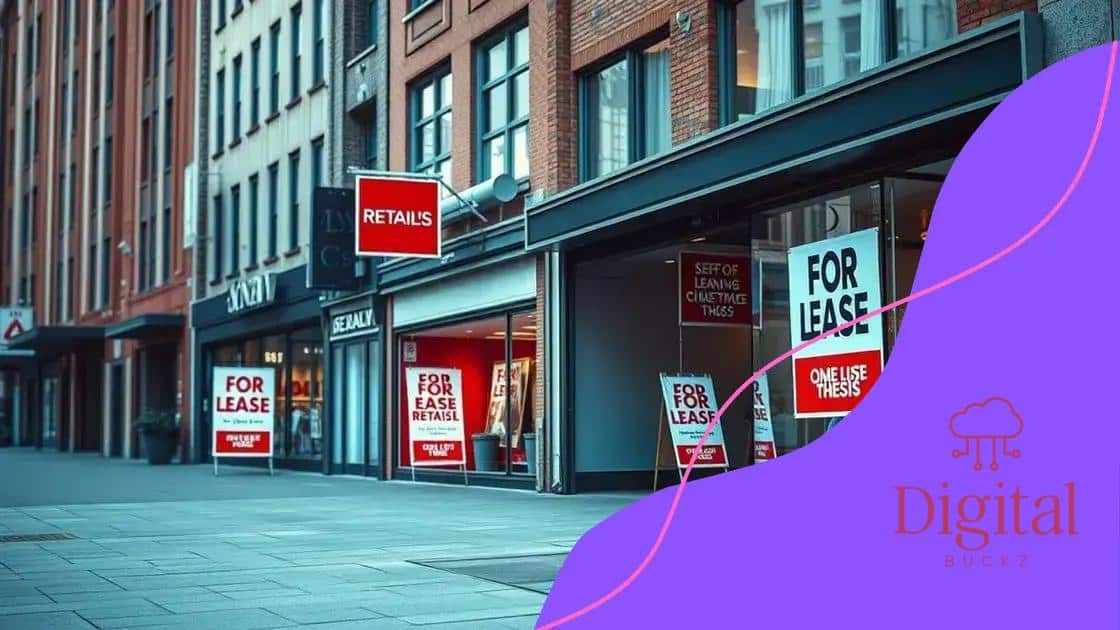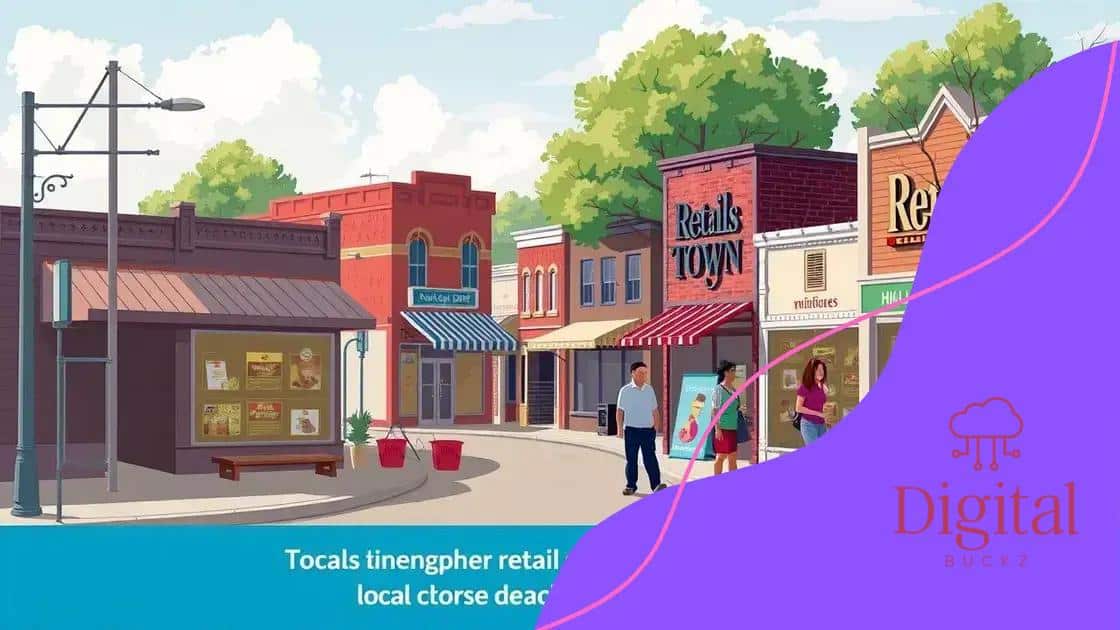Retail store closures may 2025: what to expect

Retail store closures in May 2025 are driven by factors such as economic pressures, changing consumer preferences, and increased competition from e-commerce, necessitating adaptability in strategies for survival.
Retail store closures May 2025 might just be the topic on everyone’s lips. With changes in shopping habits and the rise of e-commerce, the landscape is shifting rapidly. Are you prepared for what’s coming next?
Current trends in retail store closures
The current trends in retail store closures reveal significant changes in the retail landscape. As we look closer at these trends, we see that many factors contribute to the decline of physical stores.
Shift towards Online Shopping
One of the most notable trends is the shift towards online shopping. More consumers are choosing the convenience of shopping from home. This preference has led to a steep decline in foot traffic at brick-and-mortar stores.
Changing Consumer Preferences
Moreover, consumer preferences are evolving. Today’s shoppers seek personalized experiences and instant gratification. Retailers that don’t adapt to these demands risk closing their doors.
Main Drivers Behind Closures
- The rise of e-commerce giants
- Increased operating costs
- Changing demographics and lifestyles
As these driving factors come into play, businesses must stay agile. Adjusting to the market’s ever-changing needs is crucial for survival. Retailers that embrace technology and enhance their customer experience may have a better chance of thriving.
Moreover, location matters significantly. Many stores in high-rent areas struggle to maintain profitability. They often face hard decisions regarding their future. These challenges can lead to closures if not addressed.
Focus on Omnichannel Strategies
To combat these trends, many retailers are now adopting omnichannel strategies. This approach integrates online and offline shopping experiences, providing customers with what they want, where they want it.
Investing in a strong online presence while maintaining excellent in-store service can bridge the gap. However, it requires a balanced investment between both platforms to succeed.
Reasons behind the increasing store closures
Understanding the reasons behind the increasing store closures is essential for grasping the current retail landscape. Various factors are contributing to this trend, and each plays a vital role in the future of brick-and-mortar stores.
Economic Factors
One significant driver is the economy. Many retailers struggle with rising operational costs, including rent and wages. When profits dwindle, maintaining a physical store becomes challenging.
- High rent prices
- Increased utility expenses
- Rising labor costs
These economic pressures can push retailers to close stores, especially those in precarious financial positions.
Consumer Behavior Changes
In addition to economic factors, shifts in consumer behavior heavily influence closures. More shoppers are moving online, seeking convenience and competitive prices. This transition is reshaping how consumers interact with retail brands.
As people opt for e-commerce platforms, traditional retailers face a noticeable decline in foot traffic. They must rethink their value propositions to retain customers.
Competition from E-commerce Giants
The rise of e-commerce giants is another reason behind this trend. Retailers find it hard to compete with companies that offer lower prices, vast selections, and quick delivery options. Online shopping has transformed consumer expectations, making it difficult for physical stores to keep up.
Moreover, specialized stores may struggle against larger competitors that can afford to lower prices. A fierce competitive landscape often leads to closures of smaller, less resilient businesses.
Technological Advancements
Lastly, technological advancements play a critical role. Retailers that do not adopt new technologies or improve efficiency risk falling behind. Keeping up with trends in technology, such as in-store experiences and omnichannel strategies, is essential for survival. Integrating technology effectively can significantly enhance customer experiences and sales.
Impact on local economies and communities

The impact on local economies and communities due to retail store closures is profound and wide-ranging. Every store that closes can ripple through the community, affecting jobs, services, and the overall economy.
Job Losses
When retail stores shut their doors, one of the most immediate consequences is the loss of jobs. Many employees find themselves out of work, adding to the unemployment rate. This can create a cycle where fewer jobs lead to decreased spending in the local area.
- Increased unemployment rates
- Reduced household incomes
- Decreased consumer spending
Consequently, local businesses may suffer from lower sales, further compounding economic challenges.
Decline in Local Services
A decline in retail can also lead to a decrease in local services. Smaller shops, restaurants, and service providers benefit from foot traffic generated by nearby retail stores. Without these stores, local businesses may face hardship, resulting in fewer options for residents.
As services diminish, areas can become less attractive for new businesses and residents, leading to a further decline in the community’s vitality. In addition to this, the closures may deter investment in the area, stalling economic growth.
Community Identity and Cohesion
Moreover, retail closures can affect a community’s identity and cohesion. Many local shops contribute to the unique character of neighborhoods. When these stores close, residents may feel a sense of loss.
The sense of belonging and local pride can diminish, impacting community engagement and social interactions. Events and gatherings often centered around retail venues may also decline, further fragmenting community ties.
Future Prospects
For communities facing these challenges, it is essential to consider alternative strategies. Efforts to attract new businesses or support local entrepreneurship can help revitalize areas.
Encouraging investment in shared spaces, such as community markets, can provide a boost. Finding innovative solutions to counteract the negative effects of retail closures is crucial for sustaining local economies.
Future of retail: adapting to changes
The future of retail is marked by rapid changes that demand adaptation from businesses. As consumer behaviors evolve and technology transforms shopping experiences, retailers must embrace new strategies to stay relevant.
Embracing Technology
One crucial aspect of adapting to changes is embracing technology. Retailers can leverage tools like artificial intelligence and technology-driven solutions to personalize customer experiences. This can include chatbots for customer service or apps that enhance the shopping experience.
- Using analytics to understand customer preferences
- Implementing AI for inventory management
- Creating mobile-friendly shopping experiences
By integrating these technologies, retailers can meet customer needs more effectively.
Focus on Customer Experience
Another significant factor is the focus on customer experience. Today’s shoppers look for more than just products; they seek engaging experiences. Businesses that provide personalized interactions can cultivate customer loyalty.
Building a community around the brand can help as well. Events, loyalty programs, and social media engagement can enhance the customer’s connection to the store.
Adapting to Sustainability Trends
Additionally, sustainability is becoming increasingly important. More consumers are choosing brands that prioritize eco-friendly practices. Retailers can adapt by sourcing sustainable products and reducing waste.
This not only attracts a conscious consumer base but also helps in building a positive brand image. Retailers can implement recycling programs or use sustainable packaging to show their commitment to the environment.
Flexible Business Models
Finally, flexibility in business models is essential. Retailers need to be agile in their approaches, allowing them to respond quickly to market changes. This could mean adopting omnichannel strategies that seamlessly combine online and offline shopping.
Retailers that can pivot their business models and innovate are likely to thrive in the uncertain retail landscape of the future.
Strategies for surviving in a challenging market
In a challenging market, having effective strategies for surviving is crucial for retail businesses. The ability to adapt to changing circumstances can determine whether a store thrives or struggles.
Understanding Your Customer
One of the first steps is to understand your customers’ needs better. By conducting regular surveys and using customer feedback, retailers can learn what consumers want and adjust their offerings accordingly. This emphasis on customer insights can lead to better product selection and improved satisfaction.
- Analyze customer purchasing patterns
- Gather feedback through social media or direct surveys
- Tailor products and services to customer preferences
Knowing what your customer values will allow you to provide relevant solutions that keep them coming back.
Diversifying Product Offerings
Diversifying product offerings can also help businesses weather tough times. This strategy involves bringing in new products that complement existing ones or exploring different categories. By doing so, businesses may attract new customers and encourage current shoppers to spend more.
For example, a clothing store might start selling accessories or lifestyle products. This not only boosts sales but also enhances the customer’s overall shopping experience.
Implementing Cost-Effective Practices
Another important strategy is to implement cost-effective practices. Retailers should regularly review their operational costs to identify areas for savings. This can include negotiating better terms with suppliers or reducing unnecessary expenses.
Streamlining inventory processes can also help in maintaining healthier cash flow. Efficient stock management ensures that businesses are not overstocked or understocked, allowing them to meet demand without excess costs.
Investing in Marketing and Online Presence
In addition, investing in marketing and strengthening your online presence is vital. With the rise of e-commerce, having a robust digital strategy is essential for reaching modern consumers. This includes utilizing social media, email marketing, and SEO to attract and retain customers.
A strong online presence not only boosts sales but also builds brand recognition, making it easier for consumers to remember and trust your business.
Building Strong Community Relationships
Lastly, building strong relationships within the community can provide invaluable support. Participating in local events and collaborating with other businesses can enhance visibility and foster loyalty.
Strong community ties can also create a supportive customer base that stands by the business during tough times. Engaging with locals helps create a sense of belonging and mutual support, benefiting both retailers and community members.
In conclusion, as we look to the future of retail, it is clear that adaptation is key to survival. Retailers must embrace technology, focus on customer experience, diversify product offerings, and maintain strong community ties. These strategies can help businesses not only survive but thrive in a challenging market. By staying attuned to consumer needs and being flexible, retailers can navigate change and build lasting success.
FAQ – Frequently Asked Questions About Retail Strategies
What are the best ways to understand my customers?
Conducting surveys and analyzing customer feedback helps retailers understand preferences and needs effectively.
How can diversifying products help my retail business?
Diversifying products can attract new customers and encourage existing ones to spend more, increasing overall sales.
What cost-effective practices should retailers consider?
Retailers should review operational costs, negotiate with suppliers, and implement efficient inventory management to save money.
Why is a strong online presence important for retailers?
A strong online presence boosts visibility and engagement, making it easier for retailers to reach and connect with modern consumers.






